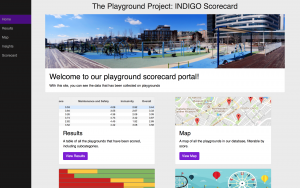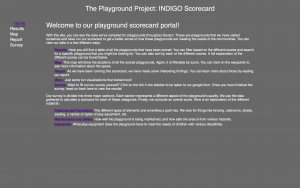 For the past three years, The Playground Project: INDIGO has been developing a scorecard to quantify the quality of playgrounds. With the data gathered from this effort, we have been able to provide more effective insights and advocacy for the state of inclusive play throughout Boston. However, until now, the data and scorecard have only been available internally. With this project, I set out to build a portal for community partners and parents alike to view our data and run the scorecard for themselves.
For the past three years, The Playground Project: INDIGO has been developing a scorecard to quantify the quality of playgrounds. With the data gathered from this effort, we have been able to provide more effective insights and advocacy for the state of inclusive play throughout Boston. However, until now, the data and scorecard have only been available internally. With this project, I set out to build a portal for community partners and parents alike to view our data and run the scorecard for themselves.
This project represented many firsts for me. This was my first time building a fully functional website from scratch, working with libraries like D3.js, and doing major design work. With this came plenty of learning pains. There were several moments throughout the project that made me want to just throw my hands up in the air, a feeling at once very familiar as a software developer. I would just learn as I coded, which while maybe not the most efficient for the project as a whole, proved effective as a learning experience and as a method for me to hit my deadlines.
 A common problem among software developers is design. While many of us are capable of coding anything we want, it takes an entirely different skillset to effectively design a program. With this in mind, I used the skills I learned from my Human Computer Interaction course, taught by my faculty mentor for this project, Dr. Timothy Bickmore, to build the website based on principles from established design heuristics. Even with that knowledge, the initial version of my website was not a pretty sight. It took rounds of user testing and discussions with others before I had a good grasp of what would be the best way to improve it. With this new information, I was able to overhaul the design of my website to something that looks more modern and works better on mobile devices.
A common problem among software developers is design. While many of us are capable of coding anything we want, it takes an entirely different skillset to effectively design a program. With this in mind, I used the skills I learned from my Human Computer Interaction course, taught by my faculty mentor for this project, Dr. Timothy Bickmore, to build the website based on principles from established design heuristics. Even with that knowledge, the initial version of my website was not a pretty sight. It took rounds of user testing and discussions with others before I had a good grasp of what would be the best way to improve it. With this new information, I was able to overhaul the design of my website to something that looks more modern and works better on mobile devices.
My process ultimately reflected the process of software development that I have grown quite accustomed to. It is all about iteration. First, build something that is functional, even if it is just a base set of features. Then, once the groundwork is set, focus can shift to improvements, fixes, and design work.
